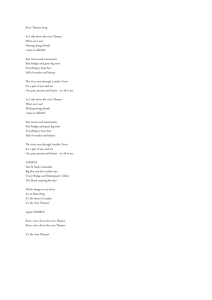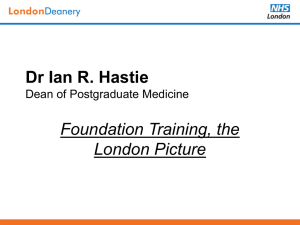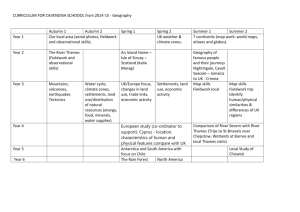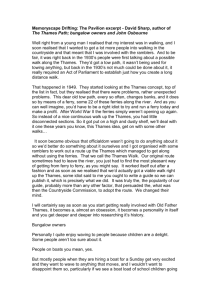THAMES PATH GEOTRAIL
advertisement
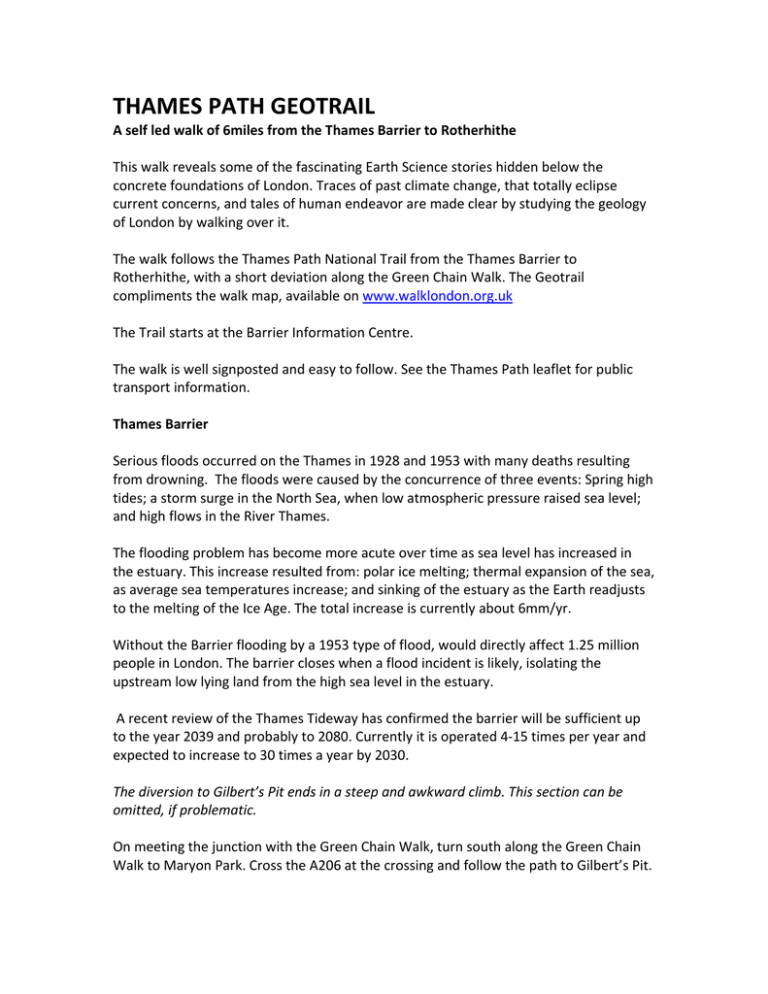
THAMES PATH GEOTRAIL A self led walk of 6miles from the Thames Barrier to Rotherhithe This walk reveals some of the fascinating Earth Science stories hidden below the concrete foundations of London. Traces of past climate change, that totally eclipse current concerns, and tales of human endeavor are made clear by studying the geology of London by walking over it. The walk follows the Thames Path National Trail from the Thames Barrier to Rotherhithe, with a short deviation along the Green Chain Walk. The Geotrail compliments the walk map, available on www.walklondon.org.uk The Trail starts at the Barrier Information Centre. The walk is well signposted and easy to follow. See the Thames Path leaflet for public transport information. Thames Barrier Serious floods occurred on the Thames in 1928 and 1953 with many deaths resulting from drowning. The floods were caused by the concurrence of three events: Spring high tides; a storm surge in the North Sea, when low atmospheric pressure raised sea level; and high flows in the River Thames. The flooding problem has become more acute over time as sea level has increased in the estuary. This increase resulted from: polar ice melting; thermal expansion of the sea, as average sea temperatures increase; and sinking of the estuary as the Earth readjusts to the melting of the Ice Age. The total increase is currently about 6mm/yr. Without the Barrier flooding by a 1953 type of flood, would directly affect 1.25 million people in London. The barrier closes when a flood incident is likely, isolating the upstream low lying land from the high sea level in the estuary. A recent review of the Thames Tideway has confirmed the barrier will be sufficient up to the year 2039 and probably to 2080. Currently it is operated 4‐15 times per year and expected to increase to 30 times a year by 2030. The diversion to Gilbert’s Pit ends in a steep and awkward climb. This section can be omitted, if problematic. On meeting the junction with the Green Chain Walk, turn south along the Green Chain Walk to Maryon Park. Cross the A206 at the crossing and follow the path to Gilbert’s Pit. Gilbert’s Pit London lies in a gently sloping basin of sedimentary rock. A series of sands, pebbles and clay was deposited into the river estuary and a coastal sea over many millions of years. Glbert’s Pit shows the complete range of deposits, illustrated on the information panel. With the oldest at the bottom the, sequence is:‐ • Blackheath Beds, flint pebbles • Woolwich Beds, sand and clay • Thanet sand • Chalk The chalk lies under the present floor of the pit, buried by wartime bombing rubble and waste dumped in the pit. Chalk was used for lime manufacture and agriculture. One of the major reasons for locating the Thames Barrier where it is was the presence of structurally strong chalk at river level. Gilbert’s Pit is an important teaching aid for engineers designing building foundations as it demonstrates the variability of London’s subsoil. The pit once supplied building sand, chalk and pebbles. Woolwich Arsenal nearby used quality sand from the pit for use as moulding sand for casting cannons. Take the opportunity to climb to the top of the hill to see the magnificent view of London. Walk back towards the Thames Barrier to rejoin the Thames Path and turn left to continue the trail.. Anchor & Hope pub At low tide groups of chalk blocks can be seen in the mud. These are the remains of hard standings built to support barges, grounded at high tide for unloading at low tide. This chalk may have come from the nearby Ballast Pit now home to Charlton Athletic Football Club. Jetty The building of London’s Docks. The geological map shows areas of “made ground” this is where soil excavated from the docks was spread on the surrounding land, raising it substantially above high tide level. Every time a ship entered the dock at high tide it brought with it a load of silt and clay so the dock would eventually need dredging to maintain its water depth. The need for dredging was overcome by pumping in clean water, thus maintaining dock water levels higher than river high tides. One source of fresh water was Brunel’s Tunnel at Rotherhithe. Springs also supplied fresh water at several locations nearby. O2‐Millenium Dome Looking north from here, less than half a million years ago a huge glacier up to 1km high would be apparent. During the Anglian Ice Age this glacier moved as far south as Finchley. Fossils have been found in Finchley that have been carried south from the Chilterns by the glacier. There have been many warm periods and ice ages since then but the impact of this glacier remains. The glacier altered the course of the Thames to the current one. The Thames originally flowed through Chelmsford and entered the North Sea near Frinton. As the glaciers moved south they pushed the Thames down the Lea Valley and into its present course. For this reason the Lea Valley looks much wider than its current flow would require. Enderby Wharf During the excavation of the original Blackwall Tunnel there was difficulty in ensuring the stability of a gravel‐filled depression in the surrounding London clay. Eventually the cause of this formation was tracked down to a ‘pingo’ left behind by an ice age. (Pingos are formed by the growth of an ice block formed in a section of permafrost being subsequently buried and filled with gravel as the ice finally melts). Greenwich Structurally London sits within the form of an eroded basin running from the North Downs in the south to the Chilterns in the north. The steps in its formation were:‐ • Deposition of sediment • Folding as it was squeezed northward • Erosion of the exposed mountain tops The squeezing was caused by the collision of the European tectonic plate with the northward moving African Plate. This collision formed the Alps and is responsible for earthquakes and volcanoes around the Mediterranean. In Britain the effects are a gentle crumple. Greenwich understandably objected to being pushed northward, and the plate fractured, forming a fault. This runs roughly east‐west about half a mile south of the Thames. The northern part has sunk about 10‐30m, forming the low range of hills seen in Greenwich Park. Greenwich Foot Tunnel The pedestrian tunnel was one of the earliest tunnels under the Thames. Dug through formations lying above the easily worked London clay, the difficulties in tunneling may well have warned the London Underground engineers to subsequently stay clear of South London, concentrating on underground railways in the easier London Clay north of the river. St George’s Wharf One of the geological structures associated with the Thames is the formation of gravel terraces along the Thames valley. The Old Naval College and the National Maritime Museum are built on one of these. This particular gravel is called Kempton Park Gravel after the major outcrops found there. It was formed by a major movement of river sand and gravel in a milder interval between two ice ages, about 100,000 years ago. This deposit is the most recent one of 12 clearly separate terraces. By careful analysis the origin of the gravel and the climate at the time of deposition can be established. Barnard’s Wharf In several places along the Thames the remains of a drowned forest may be seen. The most striking views of it are in Erith, to the east of the Thames Barrier. However many examples of it, in the form of tree trunks and peat lenses, were found during the excavation of the docks. The average age of the forest was about 5000 years old and the most common tree was the Alder. Durand’s Wharf Contaminated land is a common problem during recent building projects along the Thames. It was one of the factors in the O2 Millennium Dome project as expensive soil remediation could be justified to generate a large clear site. Here, during the building of the Jubilee underground line, severe creosote contamination was found. It was caused by the burial of creosote tanks used in the original timber yard and delayed completion of the project. Jubilee line A novel method of tunneling was used for this line as the geological structure encountered would not permit unpressurised drilling. A bentonite clay (also used for cat litter) mixture was fed to the tunneling machines’ cutting head. This isolates the pressurized head from the rest of the machine and allowing workers to enjoy an unpressurised working environment. Interestingly, satellite ground surveys have picked up the subsidence of the replaced overburden over the tunnels of the Jubilee line. Rotherhithe Street Originally the Thames was far wider than the present embanked channel. By looking down Rotherhithe Street, which was flooded in 1928, it can be seen to be well below the level of the dock quays and normal high tides. Rotherhithe Tunnel The soil though which the tunnel was dug was extremely unstable; described as, ”silty clay with locally developed beds of fine to coarse grained sand mainly less than 1m thick but locally up to 4m thick”. This is the infamous ‘Woolwich and Reading beds’ seen at Gilbert’s Pit. The tunnel was dug close to the surface, so close it was said that the tunnellers could hear the engines of boats passing overhead. The difficulties experience by the Brunels, father and son, are a catalogue of Herculean effort and final success, which we still benefit from today. Their story is told in the Brunel Museum at Rotherhithe. This is the finish of the walk. To retun to the Thames Barrier take the underground at Bermondsey or the Thames Clipper boat to North Greenwich and then the 161 or 472 bus to the top of Eastmore Street. This trail has been prepared by the South London RIGS group associated with the Ravensbourne Geological Society 6TH February 2010.

